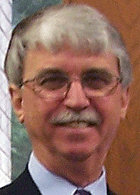Nearly 15 years ago, energy usage at both the Medical and Danforth campuses was operating near maximum capacity. Today, it’s a whole new story.
On the Danforth Campus in 1992, utility systems could not support future building growth; utility infrastructure was obsolete and inefficient; the central steam plant was coal fired, labor intensive and environmentally unfriendly; steam losses exceeded steam loads during summer operation; electrical capacity was near its limit; electrical distribution was unreliable; and many buildings were not air conditioned.
“As an example, the only major summer steam load on the Danforth Campus was for chiller operations — for air conditioning — and the chillers were inefficient and the steam load was not great enough to use all the steam produced,” said Ralph Thaman, associate vice chancellor and director of facilities planning and management. “Therefore, steam was wasted causing the excessive use of fuel that was costly.”
To solve these issues, the Danforth Campus facilities department outlined a series of objectives to help ease the energy strain, including: increasing the reliability and capacity of the utility systems; updating the systems technology; reducing energy consumption and operating cost; and being environmentally friendly.
An additional goal was to accomplish all of these changes with the least amount of disruption and cost.
“Both the Danforth and Medical campuses burned coal, and without the proper equipment to eliminate the emissions, we were faced with having to shut down or spend millions of dollars to become more environmentally friendly,” Thaman said.
Millions in savings
Since 1992, the School of Medicine has saved $26 million as a result of various equipment upgrades and other energy-saving measures.
According to Walt Davis, assistant vice chancellor and assistant dean of facilities at the School of Medicine, the medical campus Department of Facilities Management has been replacing and upgrading old systems to improve efficiency and reliability, cut costs and reduce energy use.

Among the many changes were replacing inefficient boilers, chillers and other production equipment with more efficient and reliable models; and updating heating, ventilating and air-conditioning systems in several buildings.
The School of Medicine also updated technology with automated lighting systems, variable speed systems that deliver the right amount of energy when it’s needed and an automated campus-wide chilled water system that optimizes about 18,000 tons of cooling capacity. Compare that to a typical home, which has about 2 tons to 4 tons of cooling capacity.
“Ralph, Walt and their staffs have been working diligently to make Washington University’s buildings energy efficient,” said Bruce Backus, assistant vice chancellor for environmental health and safety. “The facilities departments’ efforts dovetail very nicely with the University’s new environmental and energy initiatives.”
Pratim Biswas, Ph.D., the Stifel and Quinette Jens Professor of Environmental Engineering Science and chair of the newly created Department of Energy, Environmental and Chemical Engineering, and John Klein, executive vice chancellor for administration, are leading these initiatives.
“Pratim and John, with Ralph and Walt, are working together to integrate environmental research and teaching into university operations,” Backus said, “with the hopes that the University will become a leader in energy efficiency and that University operations will provide faculty and staff with environmental research and teaching opportunities.”
Another challenge facing both campuses is keeping up with the significant building growth seen since 1990. The Danforth Campus has seen the square footage of building space grow by 53 percent, with anticipated future growth expanding at approximately another 22 percent.
Square footage of new and renovated buildings on the medical campus has increased by more than 50 percent over 15 years. By 2009, the medical school plans to add another 350,000 square feet of building space, Davis said.
In the past few years, efforts to increase energy efficiency have kept electricity use relatively flat, while square footage has grown by more than 12 percent.
Revamped fume hoods
Laboratory fume hoods and air-handling systems consume significant energy on both the Danforth and medical campuses.
Because of the chemicals and materials used in research labs, air cannot be re-circulated throughout the buildings as it could in a home — air is heated or cooled once, then it is exhausted out, and that costs a lot.
On the Danforth Campus, facility engineers have worked with a manufacturer to develop a fume hood that controls the chemicals and gases while using a significantly lower volume of air, thus saving energy costs.
Growth in facilities presents major challenges, as well as a need to develop solutions and new goals, including energy conservation and reducing operating cost; air conditioning all buildings; shutting down the central steam plant in the summer; replacing a single high-pressure steam plant with distributed low-pressure plants located near loads; installing computer-based campus energy management systems; increasing electrical capacity and improving reliability; and designing for maximum flexibility and future growth.
Reliability improves
“Fifteen years ago, the Danforth Campus had two electrical feeds from AmerenUE, but they were on the same poles coming from the same substation,” Thaman said. “If one pole was hit, the entire campus went down.

“Also, we did not have any automatic switching from one feed to the other, so personnel had to be called in to make the switch. We were able to have AmerenUE install a third electrical feeder from a different substation, and we installed automatic switching equipment so following any interruption from AmerenUE, the feed would switch automatically.”
Thaman continued: “Although the University had to pay for the construction of the new feeder from AmerenUE, we were able to negotiate a cost reduction by allowing MetroLink to use the feeder as well.”
Replacing coal
As part of its efforts, the Danforth Campus has succeeded in shutting down the boiler plant in the summer and replacing coal with natural gas, using oil as a back-up fuel. Additionally, the steam distribution system has been upgraded, and boilers have been installed on the South 40.
According to Davis, the medical campus has a big focus on the reliability of the electrical, steam and chilled water systems because of the research labs and patient-care facilities. In support of that effort, the medical school and Barnes-Jewish and St. Louis Children’s hospitals back each other up in case of emergency.
His department installed new fume hoods in the Clinical Sciences Research Building that switch automatically to low flow when no one is in the area. The move from the previous fume hoods, which ran 24 hours a day, saves about $400,000 a year, said Jim Stueber, director, facilities engineering. That work caught the attention of the St. Louis chapter of the American Society of Heating, Refrigerating and Air Conditioning Engineers Inc., which awarded the project its technology award.
Now, a Danforth Campus energy management system has been implemented.
Natural gas costs
One of the big issues facing the University is the large increase in the cost of natural gas.
In FY 2002, natural gas usage on the Danforth Campus cost $1,270,821. In FY 2006, the cost was $4,100,299. Meanwhile, electricity costs have risen marginally, from $4,197,475 in FY 2002 to $4,386,394 in FY 2006.
At the School of Medicine, the total electricity cost dropped 11 percent between 2002-06 from $7.4 million to $6.6 million, while natural gas costs increased 219 percent from about $2.1 million to $6.7 million.
The Danforth Campus implemented the following energy and cost-control strategies: minimizing the energy usage to maximum extent; pursuing justifiable energy conservation projects; utilizing financial instruments for purchasing energy; and keeping manpower at minimum levels.
Researchers abound
“In addition to energy savings in University Facilities and Operations, several academic researchers are active in research related to energy and the environment,” Biswas said. “In fact, Chancellor Wrighton appointed an 18-person working group to prepare a report outlining a vision for WUSTL.
“One recommendation was for the facilities units at the University to work closely with faculty, to ensure that energy issues were a part and parcel of the academic and research enterprise.”
The group’s report can be seen online at eer.wustl.edu.
“Several faculty are also involved in cutting edge research — which may not be used in University operations today — but may some day in the future,” Biswas said. “Projects under way include using nanotechnology for reducing emissions from fossil fuel combustion systems, energy conservation, waste-to-energy conversion, solar technologies, photosplitting of water for hydrogen production and bioenergy technologies.
“Graduate and undergraduate students are involved in educational and research activities. A notable project was the one led by students in the Committee on Environmental Quality — where a set of solar panels were installed on the roof of Olin Library that tie into the grid. And a new department has been created in the School of Engineering and Applied Science — the Department of Energy, Environmental and Chemical Engineering — to further enhance WUSTL’s involvement in this area of education and research.
“Overall, this is an exciting time at the University, as faculty are teaming up to address problems of great relevance to the world.”
To view the real-time power generated by the solar panels on the roof of Olin Library, go online to http://view2.fatspaniel.net/FST/Portal/CromwellEnvironmental/OlinLibrary/EndUserView.html.
But Olin Library is hardly the sole beneficiary of environmental quality measures. According to Thaman, efforts throughout the entire University are being undertaken with environmentally friendly energy reduction goals in mind.
“We are a participant in the U.S. Green Lights program, and have replaced all fluorescent tube bulbs with T8 lamps and all ballast with electronic units,” Thaman said. “And we are trying to minimize the use of outside air. Anytime outside air is brought into a building, it has to be either heated or cooled. By reducing the amount of outside air brought into a building, there is a reduction in the use of energy.
“We have installed CO2 detectors in large lecture halls and meeting rooms, so by detecting the amount of CO2 in the room, we minimize the amount of outside air needed. CO2 is created by the occupants in the room, so fewer people means less outside air required.”
From the beginning
While several strategies can be used internally, some are in place before a building ever gets beyond the blueprint stage.
“By standardizing design, we have reduced the use of energy in the design of new and renovated space,” Thaman said.
However, there will always be challenges associated with controlling energy costs and being more efficient. Some of these include increasing capacity demands as the University grows, increasing reliability demands, an aging infrastructure, rising utility costs, stricter environmental compliance and limited manpower.
Still, the University is doing well when compared with similar institutions.
“When you compare the Danforth Campus to other peer institutions in the Midwest region as determined by the Central Association of Physical Plant Administrators, our overall energy usage is lower,” Thaman said.
“Our efforts to enhance University operations is continuous and we look to find new ways to improve the efficiency of energy utilization,” Wrighton said. “Our goal is to keep getting better year after year.”